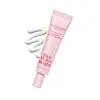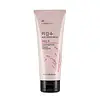The Face Shop Rice Water Bright Vegan Eye Cream Versus The Face Shop Rice Water Bright Foaming Cleanser
What's inside
What's inside
 Key Ingredients
Key Ingredients

No key ingredients
 Benefits
Benefits

 Concerns
Concerns

 Ingredients Side-by-side
Ingredients Side-by-side

Water
Skin ConditioningCaprylic/Capric Triglyceride
MaskingPropanediol
SolventGlycerin
HumectantElaeis Guineensis Oil
EmollientButyrospermum Parkii Butter
Skin ConditioningMacadamia Ternifolia Seed Oil
Emollient1,2-Hexanediol
Skin ConditioningBetaine
HumectantElaeis Guineensis Kernel Oil
EmollientBehenyl Alcohol
EmollientTri-C14-15 Alkyl Citrate
EmollientCaprylic/Capric Glycerides
EmollientTromethamine
BufferingCarbomer
Emulsion StabilisingButylene Glycol
HumectantPalmitic Acid
EmollientDisodium EDTA
Niacinamide
SmoothingPolyglycerin-3
HumectantStearic Acid
CleansingGlycine Soja Seed Extract
Skin ConditioningLactobacillus/Soybean Ferment Extract
Skin ConditioningSaccharomyces/Potato Extract Ferment Filtrate
HumectantSodium Polyacrylate
AbsorbentSaccharomyces/Barley Seed Ferment Filtrate
HumectantOryza Sativa Bran Oil
EmollientSodium Hyaluronate
HumectantHibiscus Sabdariffa Flower Extract
Skin ConditioningSaccharomyces/Rice Ferment Filtrate
Skin ConditioningOryza Sativa Extract
AbsorbentWater, Caprylic/Capric Triglyceride, Propanediol, Glycerin, Elaeis Guineensis Oil, Butyrospermum Parkii Butter, Macadamia Ternifolia Seed Oil, 1,2-Hexanediol, Betaine, Elaeis Guineensis Kernel Oil, Behenyl Alcohol, Tri-C14-15 Alkyl Citrate, Caprylic/Capric Glycerides, Tromethamine, Carbomer, Butylene Glycol, Palmitic Acid, Disodium EDTA, Niacinamide, Polyglycerin-3, Stearic Acid, Glycine Soja Seed Extract, Lactobacillus/Soybean Ferment Extract, Saccharomyces/Potato Extract Ferment Filtrate, Sodium Polyacrylate, Saccharomyces/Barley Seed Ferment Filtrate, Oryza Sativa Bran Oil, Sodium Hyaluronate, Hibiscus Sabdariffa Flower Extract, Saccharomyces/Rice Ferment Filtrate, Oryza Sativa Extract
Water
Skin ConditioningMyristic Acid
CleansingGlycerin
HumectantPotassium Hydroxide
BufferingStearic Acid
CleansingGlycol Distearate
EmollientLauric Acid
CleansingCocamidopropyl Betaine
CleansingCocamide Mea
EmulsifyingDisodium Cocoamphodiacetate
CleansingGlyceryl Stearate
EmollientPEG-100 Stearate
Sodium Lauryl Sulfate
CleansingOryza Sativa Extract
AbsorbentSaponaria Officinalis Leaf Extract
AntimicrobialOryza Sativa Bran Oil
EmollientTitanium Dioxide
Cosmetic ColorantSodium Chloride
MaskingDivinyldimethicone/Dimethicone Copolymer
C12-13 Pareth-23
CleansingC12-13 Pareth-3
EmulsifyingHexylene Glycol
EmulsifyingDisodium EDTA
CI 42090
Cosmetic ColorantCI 19140
Cosmetic ColorantCI 14700
Cosmetic ColorantHydroxypropyl Methylcellulose
Emulsion StabilisingParfum
MaskingWater, Myristic Acid, Glycerin, Potassium Hydroxide, Stearic Acid, Glycol Distearate, Lauric Acid, Cocamidopropyl Betaine, Cocamide Mea, Disodium Cocoamphodiacetate, Glyceryl Stearate, PEG-100 Stearate, Sodium Lauryl Sulfate, Oryza Sativa Extract, Saponaria Officinalis Leaf Extract, Oryza Sativa Bran Oil, Titanium Dioxide, Sodium Chloride, Divinyldimethicone/Dimethicone Copolymer, C12-13 Pareth-23, C12-13 Pareth-3, Hexylene Glycol, Disodium EDTA, CI 42090, CI 19140, CI 14700, Hydroxypropyl Methylcellulose, Parfum
 Reviews
Reviews

Ingredients Explained
These ingredients are found in both products.
Ingredients higher up in an ingredient list are typically present in a larger amount.
Disodium EDTA plays a role in making products more stable by aiding other preservatives.
It is a chelating agent, meaning it neutralizes metal ions that may be found in a product.
Disodium EDTA is a salt of edetic acid and is found to be safe in cosmetic ingredients.
Learn more about Disodium EDTAGlycerin is already naturally found in your skin. It helps moisturize and protect your skin.
A study from 2016 found glycerin to be more effective as a humectant than AHAs and hyaluronic acid.
As a humectant, it helps the skin stay hydrated by pulling moisture to your skin. The low molecular weight of glycerin allows it to pull moisture into the deeper layers of your skin.
Hydrated skin improves your skin barrier; Your skin barrier helps protect against irritants and bacteria.
Glycerin has also been found to have antimicrobial and antiviral properties. Due to these properties, glycerin is often used in wound and burn treatments.
In cosmetics, glycerin is usually derived from plants such as soybean or palm. However, it can also be sourced from animals, such as tallow or animal fat.
This ingredient is organic, colorless, odorless, and non-toxic.
Glycerin is the name for this ingredient in American English. British English uses Glycerol/Glycerine.
Learn more about GlycerinOryza Sativa Bran Oil comes from the outer layer of a rice kernel. It is a byproduct of milling rice, or the operation to produce a whole grain rice product.
This ingredient has emollient and skin conditioning properties. This is due to its polysaccharides and omega-3 fatty acids.
Emollients help soothe and soften the skin. It does this by creating a protective film on your skin. This barrier helps trap moisture and keeps your skin hydrated.
Learn more about Oryza Sativa Bran OilOryza Sativa Extract comes from the rice grain, Oryza sativa. Rice extract has wound healing, antioxidant, anti-inflammatory, and hydrating properties.
Rice grains contain numerous antioxidants which may help with anti-aging, such as vitamin E. Antioxidants help stabilize free-radical molecules. Unstable free-radical molecules may damage your skin cells and accelerate signs of aging.
A study from 2002 found rice to help increase the rate of wound healing. The same study found an improvement of skin barrier function in the patients after taking rice baths.
Numerous in-vitro studies have found rice water to help decrease sun damage by increasing collagen production and inhibiting the process of tyrosinase.
Long story short- tyrosinase is an enzyme that controls melanin production. Our bodies start producing melanin (AKA tanning) when exposed to UV radiation to protect against damage. Rice water is found to partially block this process.
Though more research is needed on rice's ability to help with UV protection, recent studies seem promising.
Wondering why rice is hydrating? The protein in rice have emollient properties. Emollients create a barrier on the skin to trap moisture in, keeping your skin moisturized.
Some rice extract may have mildly-exfoliating properties. These are mainly limited to Oryza Sativa (Rice) Bran and Oryza Sativa (Rice) Germ Powder.
This rice was first cultivated in China over 10,000 years ago. Many cultures throughout Asia have used rice water on skin and hair for centuries.
Learn more about Oryza Sativa ExtractStearic Acid is a fatty acid. It is an emollient, emulsifier, and texture enhancer.
As an emollient, stearic acid helps soften skin. It aids the skin's protective barrier by preventing water loss. It also provides a gentle cleansing effect without stripping away natural oils.
Stearic acid may also be used to enhance the texture of products. It can add volume and stabilize ingredients such as water and oil. This can help water and oil ingredients from separating.
Sources of stearic acid include animal or vegetable fats/oils such as coconut or shea. It can be naturally found in butter, cocoa butter, shea butter, vegetable fats, and animal tallow.
This ingredient may not be Malassezia folliculitis, or fungal-acne safe.
Learn more about Stearic AcidWater. It's the most common cosmetic ingredient of all. You'll usually see it at the top of ingredient lists, meaning that it makes up the largest part of the product.
So why is it so popular? Water most often acts as a solvent - this means that it helps dissolve other ingredients into the formulation.
You'll also recognize water as that liquid we all need to stay alive. If you see this, drink a glass of water. Stay hydrated!
Learn more about Water